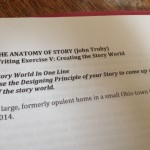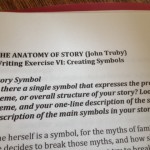This is part of the Bittersweet Book Launch case study, where Dan Blank and Miranda Beverly-Whittemore share the yearlong process of launching her novel. You can view all posts here.
By Miranda Beverly-Whittemore
Chapter Six: Story World
 After all the deep discovery prompted by the previous chapters, this chapter always feels like a sigh of relief. This might just be me, but my novels almost always come attached to a very strong sense of place, and so I have less unpacking to do. But that doesn’t mean this chapter is “easy,” no, there’s still plenty to uncover. Truby wants you to think intentionally about the metaphors and symbols of place you’ll be employing- from seasons, to weather, to the landscape- and the degree to which they have a profound influence on the kind of story you want to tell.
After all the deep discovery prompted by the previous chapters, this chapter always feels like a sigh of relief. This might just be me, but my novels almost always come attached to a very strong sense of place, and so I have less unpacking to do. But that doesn’t mean this chapter is “easy,” no, there’s still plenty to uncover. Truby wants you to think intentionally about the metaphors and symbols of place you’ll be employing- from seasons, to weather, to the landscape- and the degree to which they have a profound influence on the kind of story you want to tell.
In Worksheet Five, you look at much of the work you’ve already done through the lens of your story world. This is the chapter where I usually end up feeling as though things are really falling into place.
Chapter Seven: Symbol Web
 This chapter encourages you to use symbols to highlight and amplify the elements you’ve already put together in your book. If I’m being honest, this chapter usually feels the most “gimmicky” to me; perhaps because my first, true love is literary fiction, I find this part of Truby’s approach to be a little too formulaic for my taste. That said, I almost always find something in my own book that I didn’t know was there thanks to this chapter, so what do I know?
This chapter encourages you to use symbols to highlight and amplify the elements you’ve already put together in your book. If I’m being honest, this chapter usually feels the most “gimmicky” to me; perhaps because my first, true love is literary fiction, I find this part of Truby’s approach to be a little too formulaic for my taste. That said, I almost always find something in my own book that I didn’t know was there thanks to this chapter, so what do I know?
Chapter Eight: Plot
Finally! It’s those 22 Story Steps I was telling you about! Lo and behold, all the work you’ve done up until this point dovetails nicely into a strong, well-thought out structure.
That said, this is usually where I branch off from Truby. His method has you sitting down and assigning plot points to each Story Step, but I find that I like to go “backwards;” at this point in the game, given all the work he’s had me do, I already know what’s going to happen in the story. So instead of using a worksheet, I take flashcards and write down each moment or beat, and then, once they’re all down, I makes sure they align with most of the story steps (more on this tomorrow).
Chapter Nine: Scene Weave
My modification of Truby means that I end up with a scene weave just like what Truby ends up wanting you to have, but I come at it differently (I’ll talk more about this tomorrow). Still, it’s awesome to know that if you stick with the system, you’ll end up with a sixty scene outline at this point in the game.
Chapter Ten: Scene Construction and Symphonic Dialogue
This chapter seems very pitched to screenwriters, or for folks who want to hone their dialogue skills. What I need out of Truby is a strong outline, so I find that once I’ve gotten to this chapter, he’s given me what I need.
Chapter Eleven: The Never-Ending Story
Again, I’m usually “out” by this chapter. But he make some good points here- it’s worth looking at.
Tomorrow: The final outline
This post is part of a five part series. Click here for Part One, Part Two, Part Three, Part Four and Part Five.
